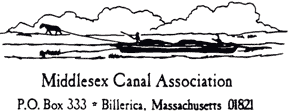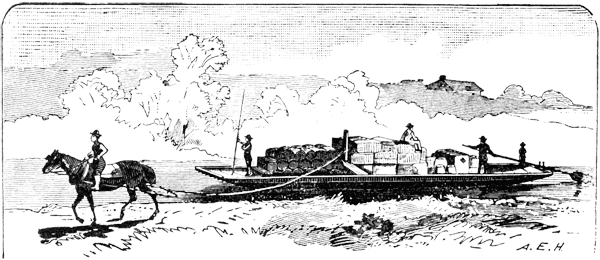


Middlesex Canal Association P.O. Box
333 Billerica, Massachusetts 01821
Volume 36, No.2 April, 1998
SPRING WALK
Saturday, April 25, 2pm
Meet at parking area after crossing the Canal at Middlesex Canal Drive in Woburn. From there we will walk south to Kilby Street and back, about 2 miles round trip. We will then drive to Baldwins Restaurant, former home of the chief engineer of the Canal, see the bicentennial canal packet boat, the statue of Loammi Baldwin, and walk the Canal to North Woburn and back, about 1 mile round trip.
Directions: Take Rte. 38 south from Rte 128 at Exit 35, as if going to the Woburn Cinemas. Take first right after the exit, at the lights. This is Middlesex Canal Drive. Cross the Canal bridge and park at rear or side of the theater. After walk ends, drive back up Middlesex Canal Drive to the lights at Rte. 38. Take left onto Rte. 38, pass under the highway to another set of lights at Alfred St. and turn right. Park at far end of rear lot of Baldwins Restaurant.
Trip leaders: Bill Gerber (978-251-4971) and Roger Hagopian (781-861-7868).
ANNUAL MEETING
Speaker and location have not been arranged yet. The date is tentatively Sunday, May 17th in the afternoon. A separate mailing about the meeting will be sent to all members and proprietors at a later date.
VISIT OF BRITISH CANALERS TO MIDDLESEX CANAL
by Nolan Jones, President
We set the date of the fall Middlesex Canal walk to be on Saturday, the day after the World Canals Conference concluded in Pawtucket, RI. A few of our British colleagues joined us for the walk. They posed for the picture below at the canal marker in Chelmsford. From left to right are Hugh Potter, Roger Squires, Peter Woodbury, Bill Gerber, Dave Barber and Ron Oakley.
In addition Hugh Potter is leading a tour sponsored by his magazine, Waterways World, in September. They plan to have lunch at the Baldwin Restaurant the day they arrive but they will not have time for any other visit to our Middlesex Canal.
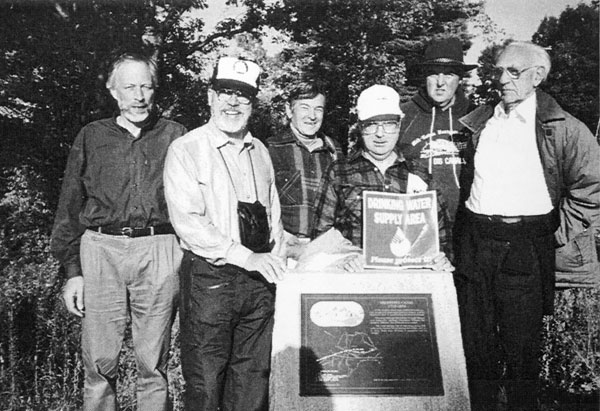
British Canal walkers (see story above)
PRESIDENT'S MESSAGE
Through the Middlesex Canal Commission, efforts of our own and others, there is probably more action to preserve the remnants of the Middlesex Canal right now than at any time in the past. We are working to put the rest of the canal in the National Register of Historic Places; the route has been mapped and owners identified; and a new book, The Incredible Ditch, has been published by the Medford Historical Society.
I must point out that some of the work is being done by contractors, which costs money. That is a serious drain on our financial resources. Any contributions would be gratefully received. One member, recently deceased, included us in his will and that contribution will be very helpful.
The process for expanding the entry in the National Register of Historic Places includes informational meetings town by town with all the owners and abutters to explain what registration means or may mean to them. The first of these meetings was held in Billerica recently. Most of the canal path in Billerica is already included in the Register so expansion of the entry means no new impact there.
That meeting generated two requests for talks to other groups. My practice is to respond to these requests as part of our effort to publicize our canal and our work.
Nolan Jones, President
CANAL HISTORY AND TECHNOLOGY SYMPOSIUM
by Nolan Jones, President
In March Joan and I attended the seventeenth annual symposium in Easton, PA, cosponsored by Lafayette College and the National Canal Museum. The subjects were varied. One talk was about the proposed ship-carrying railroad across Central America as an alternative to the Panama Canal. Another was on French movable dams on the Kanawha River. There were papers on two different gravity railroad systems in Pennsylvania. Another described the difficulties with the "great embankment" across the Irondequoit Valley part of the Erie Canal. This symposium was notable in that presidents of four canal societies were present, New York, New Jersey, Pennsylvania and the Middlesex.
CANAL EXHIBIT AT HARVARD UNIVERSITY
by Alan Seaburg
From February 5 until March 27, 1998, Harvard University's Widener Library celebrated with an impressive exhibition in its lobby and mezzanine the Bicentennial of the Middlesex Canal and the publication of the Medford Historical Society's new picture-history of the Canal, The Incredible Ditch, by Carl and Alan Seaburg, and the artist Thomas Dahill. (See ordering information elsewhere in this issue.) The Incredible Ditch is the only book about the Canal to feature over 70 colored illustrations. The exhibit included blow-ups of the drawings and watercolors done by Mr. Dahill for the book, rarely seen manuscripts from the Loammi Baldwin Papers lent by the Baker Library of Harvard University's Graduate School of Business Administration, and a surveyor's level from the period lent by the Harvard Collection of Historical Scientific Instruments.
Widener Library held a well attended reception to open the exhibition on February 12. During the reception the President of the Medford Historical Society, Mr. Jay B. Griffin, thanked Ms. Pamela Matz, Curator of Exhibitions in the College Library, for arranging the exhibit and presented copies of The Incredible Ditch to Widener Library and to Baker Library; Dr. Carl Seaburg paid tribute to Fran and Burt VerPlanck, to whom the book is dedicated, for their many contributions to the task of preserving the Canal; Mr. Nolan Jones, President of the Middlesex Canal Association, spoke of that group's work; and Mr. Thomas Raphael, Chair of the Middlesex Canal Commission, spoke of the plans to restore portions of the old Canal and the recent grant from the Federal Government to prepare designs for the restoration effort.
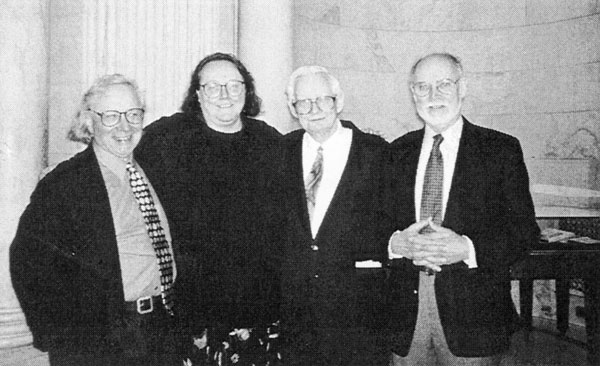
At the Widener Library Reception, (l. to r.): Alan Seaburg, Suzanne Morgan (who designed the book), Carl Seaburg, and Thomas Dahill.
THE INCREDIBLE DITCH
A Bicentennial History of the Middlesex Canal
by Carl Seaburg, Alan Seaburg and Tom Dahill
To mark the bicentennial of the Middlesex Canal, begun in 1793 and completed in 1803, this book presents an illustrated popular history of the Canal during its fifty years of operation. There is much new information in this work, and for the first time many illustrations of the Canal are presented in full color. This includes the artist's overview of the Canal as it existed in 1829 at the peak of its operation, and aerial photographs of the Canal as it existed in the 1970s.
This enterprise made possible greatly improved transportation of goods and people and opened up central New Hampshire to trade with Boston. This Canal was one of the most important of the early major transportation canals in the United States. There are sections in the book on what happened to the Canal after its abandonment, including accounts of the Middlesex Canal Association and the Middlesex Canal Commission. Large sections of it still exist and work is underway to develop and utilize it for the recreational and historical benefit of the public today.
To order this book, send your request with name and address, and a check made out to Medford Historical Society for $30.00 per copy plus $2.50 P&H to
| Medford Historical Society 10 Governors Avenue Medford, MA 02155 |
Or contact Carl Seaburg at 978-670-0876. The book is also available in some bookstores and historical societies.
BLACKSTONE RANGER GETS AWARD
by Bruce McHenry
Chuck Arning, a ranger at the Blackstone River Valley National Heritage Corridor, Uxbridge, MA, was honored by receiving the Freeman Tilden Award from the National Park Service. The award, named for Freeman Tilden, a well known author of books on the National Parks and a seminal book on Interpretation, is given to one outstanding field interpreter each year. Chuck was selected from among seven finalists. The award consists of a bronze bust of Freeman Tilden and a cash award.
Chuck received this prestigious award for his creation of the monthly cable television series "Along the Blackstone." Several of his programs featured the Blackstone Canal. Chuck's program is one excellent example of how the NPS cooperates with local media to get out information on the Parks.
MIDDLESEX CANAL ASSOCIATION TOOK TO THE BOATS
AND EXPLORED THE PAWTUCKET CANAL
by David Dettinger
Nature smiled on September 27, 1997 and provided a perfect day for a cruise on the Pawtucket Canal and the Merrimack River, an event marking the fifth year of celebration of the bicentennial of the Middlesex Canal. With the whole-hearted support of the National Park Service at Lowell, 50 canal enthusiasts boarded boats for a tour of this historic Canal, followed by a lecture on its brief role as a competitor with the Middlesex Canal, and its ultimate use as a power canal.
By coincidence, the Park Service had designated September 27 as Pawtucket Canal Day, offering free rides and special exhibits. They were pleased to have us participate, and arranged a separate cruise at an early hour. Accordingly, our group met at the Visitors Center, heard a brief introduction to the Lowell Canal System, and boarded a trolley for the boat landing just above the Swamp Locks. (Alas, these locks have yet to be restored to operating condition; they are high on the Park Service's wish list. Reconstruction would permit travel through the entire length of the Pawtucket Canal.)
Our Park Ranger supplied interesting information continually as we traveled west toward the guard lock at Francis Folly, so named by critics. The Folly is actually a guillotine-like structure that can drop a heavy gate across the Canal in case of imminent flooding. It has more than once saved Lowell from calamity. The lock dropped us to river level, and we floated out in bright sunshine with a gentle breeze. We made our way upstream as far as the bridge at Columbus Street, with our guides pointing out highlights along the shore.
As we turned back, we passed close to the spot where the Middlesex Canal began. The location has become obscure, but Roger Hagopian had taken the trouble to mark it with flags as exactly as possible. From there we floated back to the Pawtucket Dam before heading into the Canal for the return trip. The trolley was awaiting us, and back we went to the Visitors Center for some welcome refreshments.
At noon the Park Service had scheduled an open lecture prepared by one of our Proprietors, Dave Dettinger, dealing with the history of the Pawtucket Canal. Dave laid out the background for the Canal by describing the early settlements along the Merrimack River and the efforts of the merchants to increase trade with communities upriver, especially to obtain timber from New Hampshire to feed the needs of the booming boat-building industry of Newburyport. Dave's sources included the Historical Society of Old Newbury, located at the Cushing House Museum in Newburyport, the National Park resources in Lowell, the Baker Library Historical collections at the Harvard Graduate School of Business Administration, as well as the books by Clarke, Roberts, and Lewis.
Serious action began in 1792 (a year before the Middlesex Canal was started) when a charter was granted by the Commonwealth to the "Proprietors of the Locks and Canals on Merrimack River" to overcome obstacles to transportation. The chief obstacle was the Pawtucket Falls at present-day Lowell, with a fall of over 30 feet. Bypassing these falls was the first endeavor; it required a canal 1.7 miles long, with a total of four locks. Innumerable difficulties arose, as can be imagined, there being virtually no American canal-building experiences on which to draw. (In 1796 our own Loammi Baldwin was called upon to help in final completion.)
The Pawtucket Canal saw its principal use during the years from completion in 1796 until about 1820, when traffic had dwindled to a trickle, and lack of maintenance had caused it to deteriorate. Fortunately for all concerned, about this time the Lowell mills were being conceived, and the Canal became at once a prime source of water power. The significant improvements demanded for this application have resulted in the substantial system that remains today.
The boat ride and lecture over, the attendees scattered among the many lunch spots nearby, all reporting a most enjoyable experience on the Pawtucket Canal.
LOWELL'S PORTION OF THE MIDDLESEX CANAL
SOME SUGGESTIONS AND RECOMMENDATIONS
by Allan P. Small
[Editor's note: the following ideas are taken with the author's permission from a letter he wrote to Proprietor Bill Gerber in response to Bill's article in Towpath Topics in September 1997.]
1) Consider an archaeological dig for the Black Brook Aqueduct; remnants could exist behind the center field wall of Hadley's baseball field. Were some of the large cut stones, used to form the existing stone wall that surrounds the park, from the old aqueduct?
2) Would the B&M Railroad allow for a dig to discover remnants of the entrance to the Canal/Locks?
3) MCAers and others might be interested to see the house and farm of the keeper of the Old Middlesex Inn "Howard's Inn." Was it Jacob or Willard Howard? An interesting white house exists on Wood Street at the corner of Westford and Wood Streets; this may be a Howard residence.
4) Was Lowell's Tyler Park on Westford Street named after Captain Silas Tyler, the packet boat commander? Or was it his industrious son, Jonathan, who formed the "tyrannical" Boston & Lowell Railroad?
5) The stairway to the Old Tyler Mansion appears to have survived as well - on Middlesex Street across from the U-Haul Rental.
6) Another hypothesis on "Sullivan's Harbor:" the remnants may be able to be seen behind and around the Cross Point towers.
It is hoped that these ideas will serve as an inspiration for your future work and offer some thought provoking issues for the days ahead.
THE ERIE CANAL PARK AT CAMILLUS, NEW YORK
by Alan Seaburg
The Erie Canal was dug under the aegis of the state of New York between 1817 and 1825 (it was to be enlarged in the 1830s and 1840s); it connected Buffalo on Lake Erie to Albany on the Hudson, and the entire northern region of the state to the Atlantic and the ports of the world. The result was excellent: business and trade flourished and the towns and cities along the route experienced population and economic growth.
One of the townships the canal ran through was Camillus, several miles west of the city of Syracuse. The seven mile stretch of the canal in Camillus was closed in 1917 and had been dry since 1922; over time its seven feet deep bed had become a tangle of underbrush, and trees had encroached its banks and towpath. In 1963 the general store built in 1856 by John Sims to serve the neighborhood and which also was used as a landing stop for persons traveling the canal was consumed by fire. This almost inevitable condition of destruction and decay might well have been the final chapter in the history of the canal's usefulness to the Camillus community except for the vision of Dr. David Bebee, a local dentist, and several other community activists and volunteers.
They saw in the old canal wonderful possibilities where others had seen only neglect and ruin; they saw a way to renew its life and impact by creating it anew as a canal park, as a place to find quiet, beauty, and enjoyment, as a place to learn about canal history and transportation, as a place for walking, hiking, and cross-country skiing, as a place where their neighbors could gather for picnics, have a canoe or canal boat ride, or just to do a bit of fishing. What they saw has now become the reality of today's Erie Canal Park.
In 1972 the town purchased the canal from the state and from that starting point volunteers from the area working weekly around the seasons, and year after year, cleaned up the bed of the old canal, removed trees and underbrush from its banks and made several miles of walking and hiking trails, built dams at either end, and filled it with water again. But that was only the beginning for the park and canal require an ongoing maintenance program and so volunteers meet every Saturday to care for it and to improve its usefulness.
In 1976 the store originally built by John Sims was rebuilt mostly by the volunteers to serve as the park's headquarters and as a museum for exhibiting old photographs and maps of the canal as well as models of canal locks, boats, and aqueducts. Appropriately it bears his name. The volunteers have also constructed several other outbuildings including boat houses, docks, bridges, and they also see that the area is neat, attractive, and alive with colorful flowers.
The park is open throughout the year from sunup to sunset and the Sims Museum on Saturdays from 9 am to 1 pm. Between May and October the museum is also opened on Sundays and during those same months for a small fee children and adults can have a canal boat tour. While the Erie Canal Park operates as a part of the
responsibility of the town, it is really the vision and hard work of the many volunteers, past and present, that have made and continue to make it a community success. For further information write the Sims Museum, 5750 Devoe Rd, Camillus, NY 13031 or call them at 315-672-5110.
WILMINGTON - "HOPSTOWN"
by Thomas Raphael
Shortly after the Revolution ended, farmers brought over hops vines from England to grow for Colonial breweries. Whether the Middlesex Canal created the opportunity or the soil and climate favored the growth in the area is not known, but by 1805, hops grown in Wilmington had gained a wide reputation for use in brewing quality beers.
Manifests of the Middlesex Canal barges show that from 1806-1837 there were 76,806 huge bales of hops shipped to Boston and thence by ship to a brewery in Albany. Because of their light weight, bales of hops were as large as many of today's compact cars. The total value of these shipments in 1812 currency was $2,169,430. In 1837 a blight befell the Wilmington hops crops, killing the hops farming, never to recover.
Hops vines are the "Humulus impulus" variety of the mulberry family, which includes 900 species of trees, shrubs and herbs. "Artocarpus incisa" grown in the tropics is breadfruit, which is roasted and eaten. "Ficus carica" is the cultivated fig. The Asiatic "Moms" mulberry produces the milky juice used by silkworms. Mulberry bush reeds are soaked in water and beaten into tapa cloth by Pacific Islanders. "Cannabis sativa" produces hemp used for rope and whose dried leaves and flowers are smoked for psychologic and euphoric effects.
The "Humulus impulus" vine develops flowers in which yellow grains of hop meal form as they mature. These grains secrete a valuable yellow substance consisting of essential oils, resins, tannins and an alkaloid, and which is bitter and germicidal. Prepared for beer, the hops are dried and either bleached or roasted, depending on whether a light or dark beer is to be produced. Boiling extracts the bitter taste, color and aroma.
It is said that there are a few wild hops vines here and there in Wilmington but they do not supply the Middlesex Brewery Company of Wilmington, one of the popular mini-breweries in the Boston area, although Ronald F. Dills, one of the Principals, showed the author a hops vine he is growing in a tub beside the entrance to the brewery.
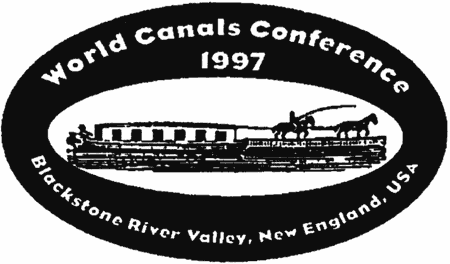
1997 WORLD CANALS CONFERENCE
by Dave Barber
The 1997 World Canals Conference was held in the Blackstone Valley on October 14-17. More than 200 people came here to attend the Conference and to learn about our Canal and the valley. Their participation gained a lot of publicity for the Canal.
The conference began on Monday with set-up and arrival of many delegates. These were directed to the Slater Mill and to the canal boat Oneida of Mid-Lakes Navigation, which was offering free rides on the river. On Tuesday the conference formally began with lunch at the Westin in Providence and a tour of the nearby Waterplace. This was followed by a tour of Blount Marine's boatyard in Warren, RI and a dinner cruise on the bay aboard the Vista Jubilee.
Wednesday began with a several venue, rotating tour of Woonsocket, followed by lunch at a choice of restaurants. The group then went by bus to the Ashton Dam and Kelly House on the Canal in Lincoln, RI, where there were walks along the towpath and an original dance presented by Fusion Works and accompanied by Pendragon. It was then back to the hotel, where the Irish delegates treated everyone to Irish coffee. Dinner that night was chicken "family style."
Thursday started off with a train ride from Providence to Worcester through the Blackstone Valley and along the Canal, followed by talks and lunch at Worcester's Mechanics Hall. The afternoon included a visit to Millville Lock and a longer stop at the Canal at Riverbend Farm in Uxbridge. The day concluded with a dinner at Pleasant Valley Country Club, a presentation of the narrative "Alice and the Blackstone," music by Pendragon, and a talk on the "Clearwater Project" (with songs) by Pete Seeger.
Friday morning, the conference concluded with a light breakfast at the old tollhouse in Lincoln and a formal 25th anniversary meeting of the American Canal Society. At this meeting, Bill Trout handed over the presidency of ACS to Terry Woods, and several long-term ACS officers were honored. Later, further papers were presented at nearby Bryant College.
After the conference, on Friday afternoon, the American Canal Society conducted a four mile hike along the Canal from Plummer's Landing to the Stanley Woolen Mill, which was heavily attended. It was followed that evening by an ACS directors' meeting and bull session at the Comfort Inn in Pawtucket. Instead of the directors' meeting, some delegates went to "firewater," a fortnightly display of bonfires with music along the river in Providence.
Those who still hadn't had enough went on a Middlesex Canal walk along that Canal on Saturday. These included High Potter, editor of Waterways World, Roger Squires, British Director of the American Canal Society, and Ron Oakley, Vice Chairman of Inland Waterways International.
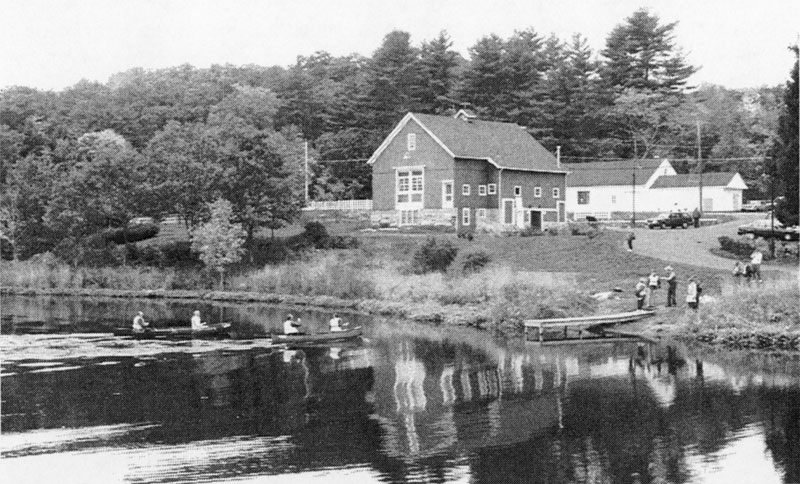
Canoeing on the Blackstone Canal at Riverbend Farm, Uxbridge, M4, October 16, 1997 at the World Canals Conference.
MIDDLESEX CANAL ANNUAL FALL WALK - 1997
by Roger Hagopian
Our annual fall walk followed the Middlesex Canal route from the North Billerica millpond at the western shore of the Concord River to Riverneck Road in Chelmsford. There were approximately 40-50 people, including a group from England who had participated in the World Canal Conference that week in the Blackstone Valley. The autumn day was highlighted by blue sky and stunning foliage.
We first observed the anchor rings that secured one end of the floating towpath on which horses pulled barges across the millpond to the entrance of the canal proper. Crossing Faulkner Street to the Talbot millyard, now the Cambridge Tool and Die Works, we viewed the only surviving lock of the original 20 on the Canal. Although mostly hidden under the millyard parking area, it appears quite intact. Here could be seen the recesses and rings which held the hinge posts for the wooden gates that retained the water level and swung open to allow passage of boats.
Walking north, we passed the old Mears Tavern on our left and heading down Faulkner Street to Lowell Street at the fire station, we directed some people through the brush to see the site of the Red Lock, which connected the Canal with the Concord River. The stone wall of the turning basin is clearly visible here. Along Lowell Street the remains of a culvert were seen; this allowed us the opportunity to explain their significance and necessity. There were 18 culverts in all, according to the Hoxie map of the Middlesex Canal (see the small MCA brochure). Like a mini aqueduct, a culvert enabled the Canal to traverse a small stream or brook. As the group crossed Route 3A, we entered a stretch of canal passing through swamp land, shaded by tall pines along the towpath. Crossing Brick Kiln Road, we found ourselves in one of the larger wildlife habitats along the Canal, pleasing to nature lovers as well as historians.
At this point we had a close encounter of the unexpected kind. Ahead of us on the dirt road towpath we noticed a cloud of dust heading toward us. Out of the dust emerged a pickup truck moving rapidly. The gentleman wanted to know what we were doing on "his" property and Bill Gerber and I, the group leaders, proceeded to explain our purpose and he grudgingly let us pass. This section of the Middlesex Canal is primarily under the jurisdiction of the Chelmsford Water Department, and the United Parcel Service, on whose land we have an easement. There were no signs prohibiting entrance from the south, where we had entered, but there are several at the northern end, although their validity is questionable. The dirt road on which we were walking is a former public way, which is now divided up the middle by the abutting properties; therefore the above gentleman owns only one side of the road along his land at best.
An experience like this emphasizes the necessity for having the entire Canal route placed on the National Historic Register, the process of which is now occurring, thanks to the work of our Secretary, Bruce McHenry. The Middlesex Canal Commission, under the leadership of our Board member Tom Raphael, has produced a series of GIS maps, which identify ownership and abutters along the Canal and aid in potential acquisition through purchase or easement of 10.6 miles of viable Canal route currently being studied.
All in all, it was one of our better walks, including seasoned members and inquisitive guests, undaunted in their enthusiasm and bringing with them a spirit of camaraderie in keeping the Middlesex Canal a living piece of American history.
HISTORIC CANAL STONES TO BE PRESERVED
by Thomas Raphael
The historic Middlesex Canal's Symmes "Aberjona" River aqueduct stones, in and adjacent to the Winchester Town Forest, are being salvaged for use by the Middlesex Canal Commission.
They are being transported to a back area of Wildwood Cemetery by Collins Development, Inc., who is constructing 10 new homes on Coventry Lane. The owner, Michael Collins, agreed to move as many of these historic stones as are available on his land and easily accessible in the adjacent Town Forest.
The stones will be stored until the Commission's purpose "to return the Canal to public use" moves to the next phase of restoring and preserving the Canal which ran through Winchester en route from Boston to Lowell.
Built-over areas will not be affected except for the placing of markers identifying the Canal's route. Two areas in Winchester where the Canal bed is still visible are at the MDC's Sandy Beach and along a work road in Wildwood Cemetery.
The stones will be used to reconstruct the MDC side of the aqueduct abutment and to provide a canal theme playground area and an interpretive site at Sandy Beach. Some of the stones had previously been taken to Wildwood Cemetery and more may be used for retaining walls by the DPW.
Some stones may be taken to other locations along the canal corridor to reconstruct aqueducts and locks, or to be used as markers or benches.
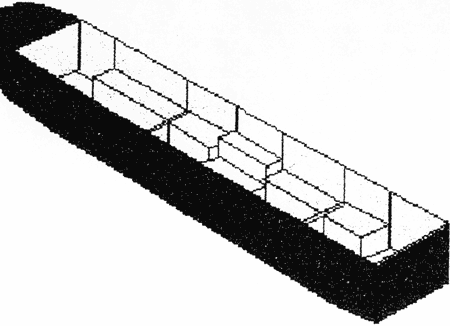
A BOAT FOR THE BLACKSTONE CANAL
by Dave Barber
The Blackstone Canal Conservancy has a project underway to put a tour boat on the Canal at Rice City Pond in Uxbridge and Northbridge, MA. Such a craft will put the public on the Canal and provide a platform for interpretation of the Canal and a discussion of further steps.
We are proceeding to build a plywood boat as pictured above to carry about 20 passengers. This craft (the "Blackstone Restoration") can be easily built by volunteers using hand tools. It is patterned after a boat currently in service on the Cotswold Canals in England. Its sectional design means that it can be easily lengthened as experience allows.
A savings account has now been established separately to hold funds raised for this project. Solicitations for financial support have been made to several local businesses. Part of the hull is now under construction.
To purchase all the materials and equipment needed, we must raise about $14,000. All who are interested in the canals of Massachusetts are requested to consider the need to move forward in this way and invited to make a substantial donation earmarked for this project. Contributions should be made to the Blackstone Canal Conservancy and noted as being for the boat project. Contributions may be sent to David G. Barber, 16 Ballou Road, Hopedale, MA 01747-1833.
LECTURE AT NATIONAL CANAL MUSEUM
by Nolan Jones, President
I was invited to give a lecture in November at the National Canal Museum in Easton, PA, as part of their fall lecture series. While there we had a tour of the Museum. Lance Metz, historian, showed us the display of the original Middlesex Canal shovel that we had loaned them in May 1997. Left to right - Lance Metz, the shovel, and me.
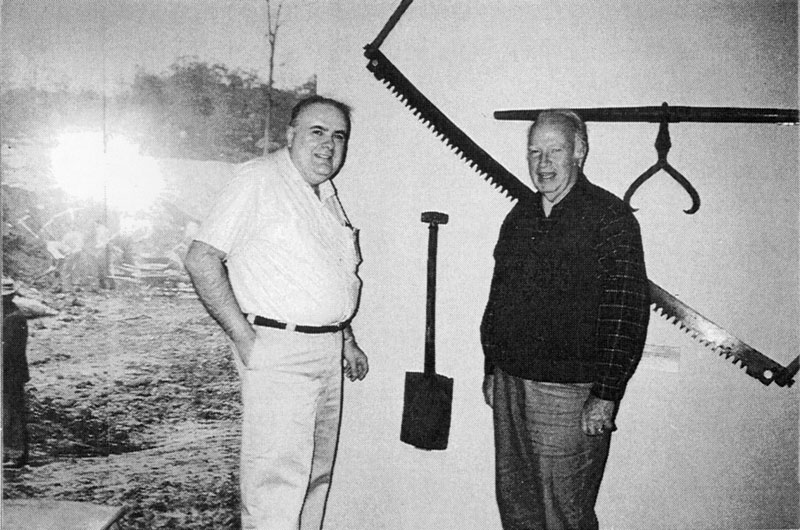
Visit of Nolan Jones to the National Canal Museum to view the Middlesex Canal shovel.
